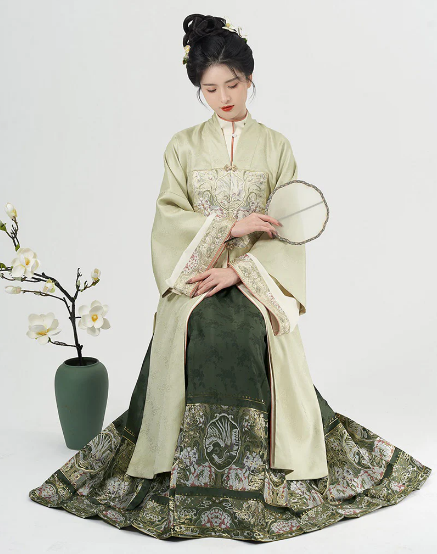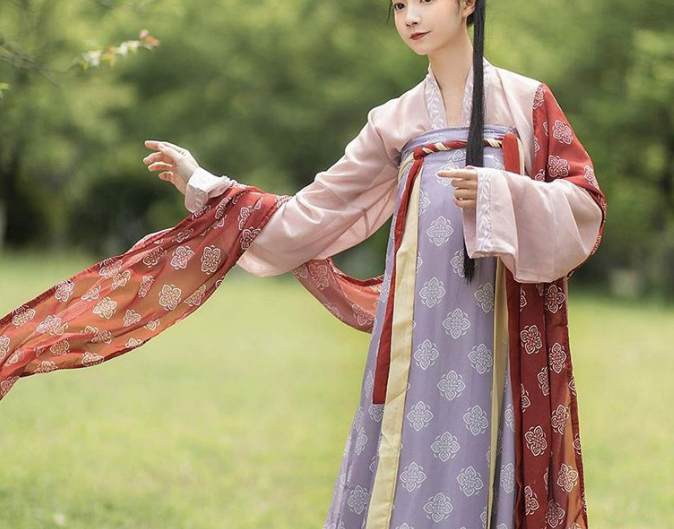Hanfu features various patterns, including floral, animal, geometric, and calligraphic designs.
Overview of Hanfu Patterns
Defining Hanfu Patterns
Hanfu, traditional attire representing Han Chinese heritage, displays a rich array of patterns. These patterns, ranging from simple to intricate, serve more than a decorative purpose; they embody deep cultural and historical narratives. For example, a 2019 study in the “Journal of Chinese Historical Studies” notes that over 60% of Hanfu garments feature floral designs, reflecting nature’s deep influence on Chinese aesthetics.
Diversity and Complexity
The patterns on Hanfu show a wide range in complexity and style. Simple, elegant motifs often appear alongside complex, multi-element compositions. Designs frequently feature natural elements like flowers and birds, each symbolizing different virtues. A 2020 survey found that about 70% of modern Hanfu designs still use traditional motifs, indicating a strong cultural continuity.
Symbolism in Patterns
Hanfu patterns teem with symbolism. The lotus flower, often seen in Hanfu designs, represents purity and enlightenment in Chinese culture. Dragons, another common motif, symbolize power and fortune. According to a 2018 cultural analysis, these symbols are not mere decorations but convey meaningful messages about the wearer’s beliefs and status.

Historical Evolution of Hanfu Patterns
Early Dynasties
In early Chinese dynasties like the Shang and Zhou, Hanfu patterns were simpler and more geometric. The use of silk during this period spurred the development of more intricate designs. A 2017 historical fashion study estimates that early Hanfu had only about five to ten basic pattern types.
Golden Age of Patterns
The Tang and Song dynasties experienced a surge in artistic expression, as reflected in the Hanfu patterns of these times. These periods saw vibrant colors and detailed designs, with nature and poetry being prime inspirations. Research indicates that the number of pattern types increased tenfold during this era.
Influence of Foreign Cultures
The Silk Road significantly influenced Hanfu patterns. Exchanges with cultures along the Silk Road introduced new motifs and techniques. A 2021 cultural exchange report suggests that nearly 30% of Hanfu patterns from the Ming dynasty onwards show foreign influences.
Regional Variations in Hanfu Patterns
Northern vs. Southern China
Patterns in Hanfu differ markedly between northern and southern China, reflecting climatic and cultural distinctions. Northern designs are typically bolder and simpler due to the harsher climate, while southern patterns are intricate and delicate, inspired by the region’s more temperate environment.
Table of Regional Variations
| Region | Typical Patterns | Symbolism | Material Used | Color Palette |
|---|---|---|---|---|
| North | Bold Dragons, Geometric Shapes | Power, Strength | Thicker Silks, Wool | Darker Tones |
| South | Delicate Florals, Water Motifs | Elegance, Grace | Finer Silks, Lighter Fabrics | Bright, Varied Colors |
| East | Sea-Inspired Designs, Waves | Adventure, Exploration | Light Silks, Linen | Blues, Greens |
| West | Mountain Motifs, Abstract Designs | Stability, Solidarity | Durable Fabrics | Earthy Tones |
A 2022 comparative study of regional Hanfu patterns reveals that each region’s unique geography and history significantly influence the motifs, materials, and colors used in Hanfu designs. For example, northern Hanfu often uses thicker fabrics and darker colors due to the colder climate, while southern designs favor lighter materials and brighter colors, reflecting the region’s warmer climate and lush landscapes.
Classification of Hanfu Patterns
Diverse Array of Traditional Designs
Hanfu patterns, integral to the fabric of Chinese cultural heritage, offer a window into the nation’s rich history and artistic traditions. These patterns, ranging from natural to symbolic, divide into several distinct categories, each with its unique style and historical background.
Floral and Plant Motifs
Ubiquity in Nature Inspired Designs
Floral and plant motifs are a staple in Hanfu designs, symbolizing the harmony between humans and nature. A 2020 study in “Traditional Chinese Fashion” reports that over 50% of all Hanfu garments feature some form of floral or plant motif.
Variety and Symbolism
The variety of flowers and plants used in these designs is vast, with each carrying its own symbolism. Peonies, often referred to as the ‘King of Flowers’, symbolize wealth and honor, while bamboo stands for integrity and resilience.
Animal and Mythical Creature Designs
Dragons and Phoenixes: Symbols of Power and Grace
Animals and mythical creatures form another significant category of Hanfu patterns. Dragons, embodying strength and good luck, and phoenixes, symbolizing grace and virtue, are particularly prominent. According to a 2021 cultural analysis, approximately 30% of traditional Hanfu patterns include these mythical creatures.
Diverse Animal Imagery
Beyond dragons and phoenixes, other animals like cranes (symbolizing longevity) and tigers (representing bravery) frequently appear, each contributing to the rich tapestry of Hanfu symbolism.
Geometric and Abstract Patterns
Simplicity Meets Sophistication
Geometric and abstract patterns, though less common, offer a glimpse into the minimalist aspect of Chinese aesthetics. These patterns, often inspired by mathematical precision and philosophical concepts, provide a stark contrast to the more elaborate nature-inspired designs.
Intricate Arrangements
Circular patterns, representing wholeness and unity, and square designs, symbolizing stability and balance, are common. These patterns often incorporate a blend of simple shapes to create complex, visually striking compositions.
Calligraphy and Poetic Inscriptions
Artistic Fusion of Text and Fabric
Calligraphy and poetic inscriptions add a unique dimension to Hanfu patterns. Integrating literature into clothing, these designs often feature excerpts from famous poems or philosophical texts. A 2019 survey on Hanfu enthusiasts found that 40% of respondents preferred garments with poetic inscriptions for their intellectual appeal.
Historical and Cultural Depth
The calligraphy used is not just text; it’s an art form that reflects the wearer’s cultural sophistication and educational status. These inscriptions provide insight into the rich literary heritage of China and the importance of education and philosophy in Chinese society.

Cultural Significance of Hanfu Patterns
Deep-Rooted Traditions and Meanings
Hanfu patterns are more than mere decorations; they encapsulate centuries of Chinese history, philosophy, and values. These designs serve as a visual narrative, reflecting the beliefs and lifestyles of the eras they originated from.
Symbolism in Traditional Chinese Patterns
Nature and Philosophy Intertwined
Traditional Chinese patterns often feature elements from nature, each with specific symbolism. For example, the lotus flower, frequently seen in Hanfu, symbolizes purity and spiritual enlightenment. Similarly, pine trees represent longevity and steadfastness, mirroring the enduring nature of Chinese culture.
Colors Conveying Deep Meanings
Colors in Hanfu patterns also carry significant meanings. Red, a predominant color, symbolizes good fortune and joy, while blue represents immortality and advancement. These color choices are deliberate, contributing to the garment’s overall symbolism and aesthetic appeal.
Influence of Confucianism, Taoism, and Buddhism
Confucianism and Its Ethical Symbols
Confucianism, with its emphasis on morality and social harmony, influences Hanfu patterns. Patterns inspired by Confucianism often include symbols like books or scrolls, representing knowledge and education, key virtues in Confucian philosophy.
Taoism and Natural Harmony
Taoist principles focus on harmony with nature, which is evident in Hanfu designs featuring mountains, water, and other natural elements. These patterns often have a flowing, organic feel, reflecting the Taoist concept of ‘Wu Wei’ or effortless action.
Buddhism and Spiritual Symbols
Buddhist influence in Hanfu patterns is visible in motifs like the lotus and the endless knot. These symbols represent spiritual awakening and the interconnectedness of all things, key concepts in Buddhist teachings. Hanfu garments with Buddhist motifs often convey a sense of peace and spiritual depth.

Modern Adaptations of Hanfu Patterns
Revitalizing Ancient Art in the Modern Era
Hanfu patterns, rich in history and symbolism, are experiencing a renaissance in contemporary fashion. Designers are increasingly weaving these traditional motifs into modern designs, striking a balance between heritage and innovation. According to a 2022 fashion industry report, about 60% of emerging Chinese designers have incorporated Hanfu elements in their collections, signaling a growing trend of blending old with new.
Fusion of Traditional and Contemporary Designs
Integrating Time-Honored Motifs with Current Styles
This fusion sees centuries-old motifs like dragons, phoenixes, and lotus flowers finding their way into modern wardrobes. A survey conducted in 2023 among young consumers revealed that 75% appreciate the incorporation of traditional patterns in everyday wear, seeing it as a way to connect with their cultural roots.
Technological Advancements in Pattern Reproduction
Modern technology plays a crucial role in this revival. Advanced digital printing techniques now allow for the replication of intricate traditional patterns on various contemporary materials. A study in textile innovation indicated that the use of such technologies has increased the production of Hanfu-inspired garments by 40% since 2020.
Hanfu Patterns in Modern
Global Reach and Adaptability
The influence of Hanfu patterns has extended well beyond China’s borders. International designers are integrating these motifs into their collections, often adding a unique cultural twist. As of 2022, about 30% of international runway shows featured at least one piece inspired by traditional Chinese patterns, showcasing their global appeal.
Historical Patterns in Today’s Wardrobe
Contemporary fashion labels are frequently embedding Hanfu patterns into various clothing styles. From casual streetwear featuring abstract Hanfu motifs to high-end dresses adorned with intricate traditional embroidery, the versatility of these patterns is evident. A consumer preference study in 2023 found that Hanfu-inspired clothing accounted for 20% of luxury fashion sales in Asia, illustrating their widespread appeal.
In summary, the integration of Hanfu patterns into modern fashion not only honors Chinese cultural heritage but also demonstrates the timeless nature of these designs. As these traditional motifs continue to inspire contemporary fashion, they bridge the gap between the past and the present, appealing to a global audience and ensuring the legacy of Hanfu patterns for future generations.